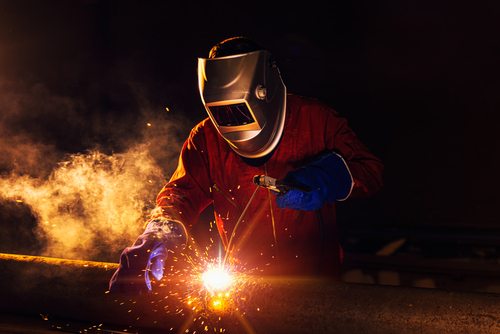MIG, TIG, and Stick welding each have their benefits and values but they may not all be suitable for your job. Here is our guide to these three types of welding options.
Stick Welding
Stick welding uses an electric current and an electrode, and it is good for common metal gauges. This is the DIYer’s preferred type of welding. Stick welders can be used just about anywhere. They can be AC or DC, with AC being the cheaper option. The most common use for this welder is home repairs, hobbies like metal sculpting, and similar roles using heavy gauge metals.
MIG Welding
MIG welders are used by trade professionals for a range of roles. The process for MIG welding is pretty straight forward, making it easier to learn than stick welding.
MIG welders incorporate a wire welding electrode which is fed through the welder at a regulated rate. In this case, the arc is made by an electrical current between metal and wire. The current heats the wire and bonds it to the metal. This produces a clean weld, making MIG welders popular for high precision work and presentation. MIG welding can also be used on thinner gauges than stick welding, including plate metals.
TIG Welding
TIG welding is a more complex process, which uses plasma to heat and bond metals. TIG welding is most commonly used to weld thin metals, including stainless steel and non-ferrous metals. This type of welding also requires a high level of proficiency and some patience because the welding process can be slower than other types of welding. TIG welding provides strong bonds, making it useful in all situations where other welders can’t perform.
The Welders and Their Work
If you’re in the metal sector, you’ll know that welding also relates directly to workflow efficiency, costs, and time.
This makes it essential to select the most appropriate option:
- Good welds are essential: All metal tradespeople will tell you that an inferior quality weld is simply not an option. Cheap welding is structurally problematic and dangerous.
- Welds must be adequate for the metals involved: If you’re manufacturing or designing a product, you need to crunch some numbers about metal gauges, types of metal, and product stress. This can get pretty technical, but the bottom line is that you need to factor welding into your cost and timeframes.
Here are some situations when you should use MIG, TIG or Stick welding:
- Steel: MIG, TIG, Stick
- Aluminium and alloys: MIG, TIG
- Metal plate: MIG
- Steel pipe: MIG, TIG, Stick
- Rectangular steel tube: MIG, TIG, Stick
- Round steel tube: MIG, TIG, Stick
- Aluminium pipe: MIG, TIG
- Cast iron: Stick
- Copper: TIG
- Brass: TIG
Using the right welder saves time, ensures weld quality, and saves money due to more efficient welding.
Trying to Source Metal for Your Business in Newcastle or Sydney?
If you’re looking for top quality metal in Newcastle or Sydney, talk to Ezimetal. We’re happy to assist and provide any support or guidance you need for metal selection. Contact us online or call us on 02 4987 4210 for all the help you need.

